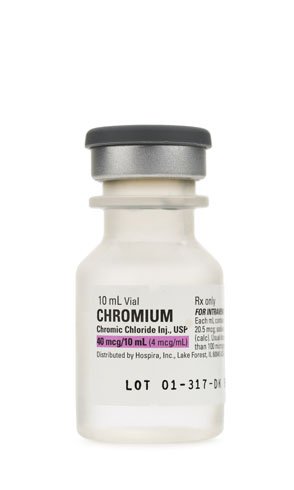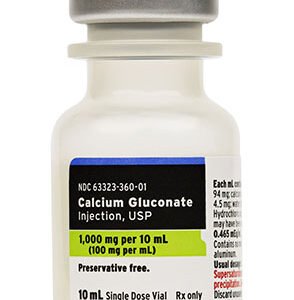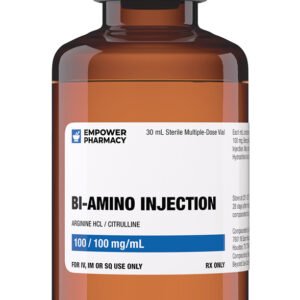Description
General Information
Chromium, in its trivalent state (i.e., Cr3+), is an essential trace element that is required for proper carbohydrate, lipid, and nucleic acid metabolism in the human body. Dietary sources of chromium (Cr3+) include whole grains, egg yolks, brewer’s yeast, liver, meats, nuts, potatoes with skin, and beer. Overt signs and symptoms of chromium deficiency are usually only observed in adult patients eating diets high in refined foods or who are receiving long-term total parenteral nutrition without chromium supplementation.Clinically, overt deficiencies may be detected as the development of impaired glucose tolerance, glycosuria, and insulin resistance. Impaired protein and lipid metabolism, peripheral neuropathy, and encephalopathy secondary to chromium deficiency have also been reported. Chromium supplementation should only be expected to improve disorders that are due to chromium deficiency. Limited studies have reported that the addition of chromium picolinate supplements to the dietary regimens of patients with type 2 or steroid-induced diabetes mellitus may result in improvements in glycemic control and cholesterol in some patients, and may allow for the reduction of antidiabetic medication.However, these trials have studied few patients; the importance of chromium deficiency in the average patient with type 2 diabetes has not been established. Controversy exists concerning other claimed benefits of chromium supplementation. Among athletes, chromium is promoted as an alternative to anabolic steroids. Multiple studies have concluded that there is no evidence that chromium supplementation increases muscle mass to a level greater than that which is produced with a healthy diet and exercise alone.There also appears to be no basis for claims that chromium reduces body-fat or weight. Clinical studies of chromium intake have revealed no additional changes in body-fat percentages or weight loss in either obese females or young athletes following controlled diet and exercise regimens.Other claimed uses, such as the adjunctive treatment to medical therapy for gestational diabetes after the 1st trimester or the adjunctive treatment of dysthymic disorder, are not accepted at this time. In the US, sales of chromium picolinate supplements exceed 150-million dollars per year.
Mechanisms of Action
Chromium, in its trivalent state (i.e., Cr3+), is an essential trace element that is required for proper carbohydrate, lipid, and nucleic acid metabolism in the human body. Dietary sources of chromium (Cr3+) include whole grains, egg yolks, brewer’s yeast, liver, meats, nuts, potatoes with skin, and beer. Overt signs and symptoms of chromium deficiency are usually only observed in adult patients eating diets high in refined foods or who are receiving long-term total parenteral nutrition without chromium supplementation.Clinically, overt deficiencies may be detected as the development of impaired glucose tolerance, glycosuria, and insulin resistance. Impaired protein and lipid metabolism, peripheral neuropathy, and encephalopathy secondary to chromium deficiency have also been reported. Chromium supplementation should only be expected to improve disorders that are due to chromium deficiency. Limited studies have reported that the addition of chromium picolinate supplements to the dietary regimens of patients with type 2 or steroid-induced diabetes mellitus may result in improvements in glycemic control and cholesterol in some patients, and may allow for the reduction of antidiabetic medication.However, these trials have studied few patients; the importance of chromium deficiency in the average patient with type 2 diabetes has not been established. Controversy exists concerning other claimed benefits of chromium supplementation. Among athletes, chromium is promoted as an alternative to anabolic steroids. Multiple studies have concluded that there is no evidence that chromium supplementation increases muscle mass to a level greater than that which is produced with a healthy diet and exercise alone.There also appears to be no basis for claims that chromium reduces body-fat or weight. Clinical studies of chromium intake have revealed no additional changes in body-fat percentages or weight loss in either obese females or young athletes following controlled diet and exercise regimens.Other claimed uses, such as the adjunctive treatment to medical therapy for gestational diabetes after the 1st trimester or the adjunctive treatment of dysthymic disorder, are not accepted at this time. In the US, sales of chromium picolinate supplements exceed 150-million dollars per year.
Pharmacokinetics
Chromium is administered intravenously as chromic chloride after dilution with compatible intravenous fluids and orally as trivalent chromium (Cr3+) formulated as the picolinate and nicotinate salts. Intestinal absorption of trivalent chromium from the diet is normally low (i.e., 0.5—10% of food chromium content). Atomic absorption spectrometry can accurately assess chromium levels in blood, urine, or hair, but results cannot be related to the amount of total chromium in tissue stores. Chromium appears to be distributed throughout body tissues. The metabolism of chromium in the body is still poorly understood. Diurnal variations in serum chromium occur secondary to the ingestion of meals and the subsequent increase in insulin secretion. Most chromium ingested in the diet or as supplements is excreted renally via glomerular filtration or via a low-molecular-weight organic transport system; the exact route of renal excretion is not clear but appears to approximate a two-compartment model. Normal renal excretion of chromium is < 1 mcg/24 hours. However, urinary excretion may be increased to 3—50 mcg/24 hour with chromium supplementation above dietary intake. Small amounts of chromium are excreted in the bile and small intestine.
Route-Specific Pharmacokinetics
Oral Route: Oral supplements of trivalent chromium (Cr3+) are formulated as the picolinate and nicotinate salts to improve bioavailability (i.e., roughly 10—50% bioavailable).
Contraindications / Precautions
Some chromium products are not for human use or ingestion. Chromium products labeled for industrial or craft use can be very toxic. A case of mistaken ingestion of a chromium-containing leather tanning solution by a patient has been reported. Patients should not take chromium products that are not labeled for use as nutritional supplements. If accidental exposure to such a product occurs, the patient should be instructed to contact a local poison control center and health care professional immediately.
Parenteral chromium products must be diluted prior to intravenous administration. Direct intravenous injection or intramuscular administration is contraindicated, as the acidic pH of the parenteral chromium solution may cause considerable tissue necrosis.
Some parenteral chromium and trace element products contain benzyl alcohol and should be avoided in patients with a history of benzyl alcohol hypersensitivity. Because benzyl alcohol has been associated with a ‘gasping syndrome’ in neonates, excessive exposure to benzyl alcohol containing products should be avoided.
Patients with diabetes mellitus should pursue chromium supplementation with products such as chromium picolinate only under the supervision and advice of a qualified health care professional. Chromium supplementation may influence serum blood glucose concentrations and hemoglobin A(1c) levels; medications used for the treatment of diabetes may need dosages adjusted during chromium use. Frequent monitoring of blood sugar and other clinical parameters is recommended. Patients with diabetes should be well-versed in the detection and management of hypoglycemia.
Chromium elimination may be decreased in patients with renal disease or renal impairment. Dosage reductions in supplemental parenteral or oral doses may be needed. Since chromium is primarily excreted via the renal route, supplementation should be approached with caution, particularly in patients maintained on dialysis or with renal failure.
There is insufficient clinical data to promote chromium’s role in obesity treatment at this time. In limited but controlled clinical trials, chromium does not appear to induce significant effects on body-fat composition or weight loss.
The use of oral chromium supplements in children, like chromium picolinate, is not recommended. If dietary intakes of chromium are judged to be insufficient, the use of a general multivitamin and mineral supplement formulated for children should provide the needed nutritional supplementation (i.e., the estimated adequate intake or AI). Chromium supplementation has only been established for children receiving maintenance nutrition with parenteral nutritional formulas (TPN) to prevent or treat chromium deficiency.
Use of chromium within the recommended daily dietary intake for lactating women is generally recognized as safe.Consider the benefits of breastfeeding, the risk of potential infant drug exposure, and the risk of an untreated or inadequately treated condition. If a breastfeeding infant experiences an adverse effect related to a maternally administered drug, healthcare providers are encouraged to report the adverse effect to the FDA.
Parenteral chromium injections are classified in FDA pregnancy category C. The use of chromium in pregnancy is only established for the prevention of chromium deficiency in patients maintained on parenteral nutritional formulas (TPN). Other claimed uses for chromium, such as the use of chromium picolinate for the adjunctive treatment of gestational diabetes, are not recommended; safety and efficacy have not been established in these patients at this time. Currently available studies have not been well controlled and have not established the safety or efficacy of chromium intake in excess of the estimated adequate intake (AI) during pregnancy. Adverse effects have not been reported with the normal daily intake of chromium within the recommended dietary daily intakes for a pregnant female. The use of chromium in excess of the recommended dietary allowance during normal pregnancy should be avoided unless, in the judgment of the physician, potential benefits in a specific, unique case outweigh the significant hazards involved.
Pregnancy
Parenteral chromium injections are classified in FDA pregnancy category C. The use of chromium in pregnancy is only established for the prevention of chromium deficiency in patients maintained on parenteral nutritional formulas (TPN). Other claimed uses for chromium, such as the use of chromium picolinate for the adjunctive treatment of gestational diabetes, are not recommended; safety and efficacy have not been established in these patients at this time. Currently available studies have not been well controlled and have not established the safety or efficacy of chromium intake in excess of the estimated adequate intake (AI) during pregnancy. Adverse effects have not been reported with the normal daily intake of chromium within the recommended dietary daily intakes for a pregnant female.The use of chromium in excess of the recommended dietary allowance during normal pregnancy should be avoided unless, in the judgment of the physician, potential benefits in a specific, unique case outweigh the significant hazards involved.
Breastfeeding
Use of chromium within the recommended daily dietary intake for lactating women is generally recognized as safe.Consider the benefits of breastfeeding, the risk of potential infant drug exposure, and the risk of an untreated or inadequately treated condition. If a breastfeeding infant experiences an adverse effect related to a maternally administered drug, healthcare providers are encouraged to report the adverse effect to the FDA.
Interactions
At the time of writing, there were no reported interactions for 7-keto-DHEA. It is possible that unknown interactions exist.
Adverse Reactions / Side Effects
In a case report, rhabdomyolysis has been associated with ingestion of 1200 mcg of chromium for 2 days by an otherwise healthy body-builder. This above the recommended adequate oral intake (AI) of 200 mcg per day. Reported symptoms included dehydration, musculoskeletal pain, muscular weakness, and bilateral leg muscle cramps.
There is some initial evidence that picolinic acid, as part of the chromium picolinate salt, may generate hydroxy-radicals upon entry into cells and induce chromosomal changes. Further trials are needed to determine the safety of chromium picolinate. The clastogenesis of picolinic acid suggests the potential for the development of tumors.
Although chromium picolinate is thought to be safe, case reports of nephrotoxicity from oral supplementation have appeared in the medical literature. All subjects consumed doses well above the recommended adequate oral intake (AI) of 200 mcg per day. A dose of 600 mcg PO per day for 6 weeks reportedly resulted in chronic renal insufficiency and interstitial nephritis in one patient according to the case report.Acute renal failure (unspecified) and renal tubular necrosis have been reported secondary to chromium intake of 1200—2400 mcg PO per day for 4—5 months in another patient. Renal function returned to normal following medical treatment.
Storage
Store this medication at 68°F to 77°F (20°C to 25°C) and away from heat, moisture and light. Keep all medicine out of the reach of children. Throw away any unused medicine after the beyond use date. Do not flush unused medications or pour down a sink or drain.
Refrences
1Freund H, Atamian S, Fischer JE. Chromium deficiency during total parenteral nutrition. JAMA 1979;241:496-498.
2Anderson RA, Cheng N, Bryden NA, et al. Elevated intakes of supplemental chromium improve glucose and insulin variables in individuals with type 2 diabetes. Diabetes 1997;46:1786-1791.
3Ravina A, Slezak L, Mirsky N, et al. Reversal of corticosteroid induced diabetes mellitus with supplemental chromium. Diabet Med 1999;16:164-167.
4Clarkson PM. Effects of exercise on chromium levels. Is supplementation required? Sports Med 1997;23:341-349.
5Pasman WJ, Westerterp-Plantenga MS, Saris WH. The effectiveness of long-term supplementation of carbohydrate, chromium, fibre, and caffeine on weight maintenance. Int J Obes Relat Metab Disord 1997;21:1143-1151.
6Clancy SP, Clarkson PM, DeCheke ME, et al. Effects of chromium picolinate supplementation on body composition, strength, and urinary chromium loss in football players. Int J Sport Nutr 1994;4:142-153.
7Standing Committee on the Scientific Evaluation of Dietary Reference Intakes – Panel on Dietary Reference Intakes
8Martin WR, Fuller RE. Suspected chromium picolinate-induced rhabdomyolysis Pharmacotherapy 1998;18:860-862.
9Speetjens JK, Collins RA, Vincent JB et al. The nutritional supplement chromium (III) tris(picolinate) cleaves DNA. Chem Res Toxicol 1999;12:483-437.
10Wasser WG, Feldman NS. Chronic renal failure after ingestion of over-the-counter chromium picolinate. Ann Intern Med 1997;126:410.
11Cerulli J, Grabe DW, Gauthier I, et al. Chromium picolinate toxicity. Ann Pharmacother 1998;32:428-31






Reviews
There are no reviews yet.